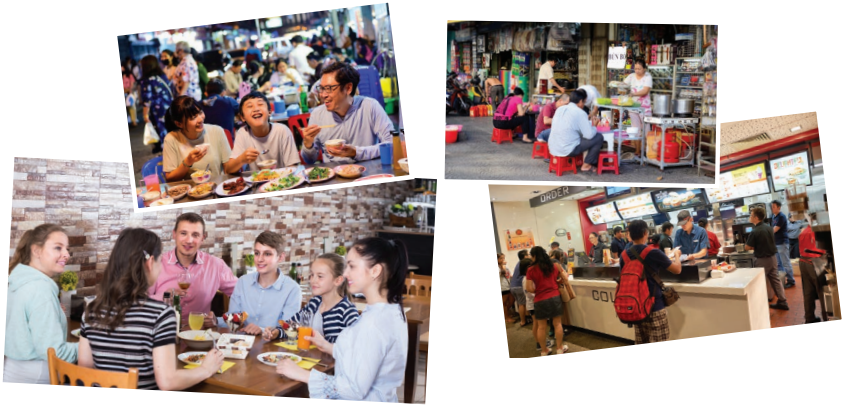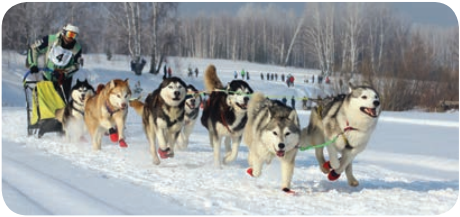2. Match the highlighted words in the text with their meanings.
(Nối các từ được đánh dấu trong văn bản với ý nghĩa của chúng.)
|
1. maintain |
a. particular ways of doing something |
|
2. styles |
b. people who drive dogsleds |
|
3. experience |
c. to do or feel something |
|
4. mushers |
d. to keep, make something continue |
|
1. d |
2. a |
3. c |
4. b |
1 - d: maintain - to keep, make something continue
(duy trì – giữ hoặc làm cho thứ gì đó tiếp tục)
2 - a: styles - particular ways of doing something
(phong cách – phương hướng riêng biệt để làm việc gì đó)
3 - c: experience - to do or feel something
(trải nghiệm – làm hoặc cảm thấy gì đó)
4 - b: mushers - people who drive dogsleds
(người lái xe chó kéo – người lái xe trượt tuyết do chó kéo)

Các bài tập cùng chuyên đề
Lifestyle differences
(Sự khác biệt về lối sống)
1. Listen and read.
(Nghe và đọc.)
Nam: Hello, Tom. How're things?
Tom: Oh good. I like it here. The lifestyle is interesting and different from that in my country.
Nam: Really?
Tom: Sure. Students here call their teachers by their title "teacher", not by their names.
Nam: Right. How do you greet your teachers?
Tom: We usually say "Hello" or "Good morning" then Mr, Mrs, or Miss and their surnames, for example "Good morning, Mr Smith."
Nam: Are there other differences?
Tom: People buy and sell a lot of street food here. In my country, people usually buy food in a store or a restaurant.
Nam: Yeah. Buying street food is a common practice in my city.
Tom: And I've noticed that many people have breakfast on the street too! In my country, we typically have a light breakfast at home.
Nam: I see. But here many adults are in the habit of having breakfast outside of their homes. If they're not in a hurry, they'll even have a leisurely coffee there.
Tom: That's fascinating!

2. Read the conversation again and complete the table.
(Đọc lại bài hội thoại và hoàn thành bảng.)
|
In Nam’s country |
In Tom’s country |
|
- Students greet teachers by their title. - People eat breakfast (2) _____. - People buy and sell food on the roadside. |
- Students refer to their teachers as Mr, Mrs, or Miss and their teachers' (1) _____. - People eat breakfast at home. - People often buy food in a (3) _____. |
Reading
1. Work in groups. Look at the picture, and discuss what you know about Alaska (its location, climate, native people, culture, ...).
(Làm việc nhóm. Nhìn vào bức tranh và thảo luận về những gì bạn biết về Alaska (vị trí, khí hậu, người bản địa, văn hóa, ....)
Read the text and check your answers.
(Đọc bài khóa và kiểm tra đáp án.)

If you go to the American state of Alaska, you might find the traditional lifestyle there interesting. Although Alaska is quite large, with nearly 1.7 million square kilometres, it has a small population of about 730,000.
The native peoples in Alaska still maintain many of their traditions. They keep their old ways of making arts and crafts alive. Various native groups have their own special styles of carving or weaving as well as their unique tribal dances and drumming. Therefore, visitors to Alaska may experience some of their culture in their villages. They may see performances of traditional music and native art in galleries and museums.
Alaska is also known for its unusual method of transport - the dogsled. Today, dog sledding (= mushing) is more of a sport than a true means of transport. The best-known race is the Iditarod Trail Sled Dog Race, a 1,510 km race from Anchorage to Nome. Mushers from all over the world come to Anchorage each March to compete for cash and prizes.
3. Read the text again and answer the questions.
(Đọc lại văn bản và trả lời câu hỏi.)
1. What is the population of Alaska?
(Dân số của Alaska là bao nhiêu?)
2. Who have special styles of carving or weaving?
(Ai có phong cách đặc biệt trong điêu khắc và dệt vải?)
3. Where can we find the culture of the native peoples in Alaska?
(Chúng ta có thể tìm thấy gì trong văn hóa của người bản địa ở Alaska?)
4. How long is the Iditarod Trail Sled Dog Race?
(Cuộc đua chó kéo Iditarod dài bao nhiêu?)
5. Is the Iditarod Trail Sled Dog Race an international competition?
(Cuộc đua chó kéo Idutarod có phải một cuộc đua quốc tế không?)
1. Listen and read the text and find:
(Nghe và đọc văn bản và tìm)
1. Two jobs _________ _________
2. Three things to eat _________ _________ _________
3. An animal _________
4. Two places _________ _________
Hi! I’m Lan and I’m fourteen years old. I live with my granny because my parents are scientists and they often work abroad. They’re in Singapore at the moment. My granny is really sporty. She is a yoga teacher and she swims in the morning. I sometimes go with her, but I don’t like getting up early.
We usually have breakfast together, then I feed my dog. Yes! I’ve got a beautiful dog called Mun. Then I go to school and I have lunch at school. I like egg rolls, sliced pork, and sometimes summer rolls. After school, I often see my friends, Thu and Duy. We like going jogging together in the park.
In the evenings, I do my homework and my granny makes dinner. She’s the best cook in the world!

4. Study the phrases and underline those that are in the text. Can you add more everyday actions?
(Nghiên cứu các cụm từ và gạch dưới những cụm từ trong văn bản. Bạn có thể thêm nhiều hành động hàng ngày hơn không?)
|
do homework (làm bài tập về nhà) |
get home (về nhà) |
|
go to school / go out (đi học / đi chơi) |
have a shower (đi tắm) |
|
have breakfats / lunch / dinner (ăn sáng/trưa/tối) |
see friends (gặp bạn bè) |
|
get up early / late (dậy sớm/muộn) |
get dressed (mặc quần áo) |
1. Choose the correct answer A, B, C, or D to fill in each numbered blank to complete the passage.
(Chọn đáp án đúng A, B, C hoặc D điền vào mỗi chỗ trống được đánh số để hoàn thành đoạn văn.)
Cultural differences occur wherever you go abroad. When visiting another country, you should be aware of those differences and respect them. Here are some (1) _________ on how to fit in.
Every traveller to a foreign country feels (2) _________ at some point. How you act may make locals laugh. Your best defense is a sense of humor. If you can laugh off eating with the wrong hand in India, locals will be more accepting of you.
Wearing proper clothes is important too (3) _________ locals will judge you by what you wear. In some Middle Eastern countries, exposing your flesh is forbidden, especially if you are a woman. So (4) _________ your torn jeans at home.
Also be (5) _________ about expressing emotions. Getting angry in Southeast Asia just makes you look silly. In some countries it is unwise to kiss in public.
1. A. plans B. tips C. arguments D. choices
2. A. unsafe B. excited C. satisfied D. awkward
3. but B. because C. so D. or
4. A. leave B. make C. bring D. take
5. A. natural B. advisable C. cautions D. unnecessary
2. Read the two passages and answer the questions on page 49.
(Đọc hai đoạn văn và trả lời câu hỏi trang 49.)
Different Lifestyles Around The World
My family moved to Sweden because of my dad's job. I went to school there for a year. Well, I didn't like it. The class was so noisy. Students would ask questions all the time. They spoke while the teacher was speaking and shouted at each other. They even sat under their desks. They sometimes called teachers by their first name. I thought it was rude! It's quite different from studying in my country.
Lan Tran, Viet Nam
I went to a foreign country and stayed with my friend's family. When I arrived, they showed me a dog and asked: "Do you like this dog?" I said: "Yeah, yeah." When it was time for dinner, I went to the kitchen and saw a plate of steaming meat. I asked: "What is this?" and they all said: "Dog meat". Oh God! They cooked the dog! I said I liked the dog, and they cooked it. I started crying, and broke down at the table.
Paul Bennett, England
1. How long did Lan Tran study in Sweden?
(Lan Trần học ở Thụy Điển bao lâu?)
____________________________________
2. Did she like to study in Sweden?
(Cô ấy có thích học ở Thụy Điển không?)
____________________________________
3. How did Lan Tran feel when Swedish students called teachers by their first name?
(Lan Tran cảm thấy thế nào khi học sinh Thụy Điển gọi thầy bằng tên?)
____________________________________
4. Whom did Paul Bennett stay with?
(Paul Bennett đã ở với ai?)
____________________________________
5. What did Paul Bennett do when he saw that they cooked the dog?
(Paul Bennett đã làm gì khi thấy họ nấu chín con chó?)
____________________________________
3. Fill in each blank with a word to complete the passage.
(Điền vào mỗi chỗ trống một từ để hoàn thành đoạn văn.)
We all want to have a healthy life and do a lot of things to stay healthy. Healthy living has a different meaning (1) _________ different people, but some of these habits are pretty simple and should be followed by everyone in order to have a happy and healthy life.
Many people try to keep fit by getting some (2) _________ a few times a week, perhaps by going for a swim, by jogging in a park, or by playing active games like football or tennis. Dancing classes are also popular. Moreover, (3) __________ a balanced diet and having enough sleep are essential too. Getting fresh air is also very important for your health, and taking few moments to get out of your chair to (4) ________ a breath of fresh air can improve your mood.
To sum up, a relaxed lifestyle, a balanced diet and plenty of (5) __________ air and exercise - these things are all important.
Read and choose the best answer that best fits each blank.
Being engaged in a DIY project can give you a sense of (1) ______________ and satisfaction. Finishing a DIY project can help you (2) ______________ accomplished and happy with your hard (3) ______________ and dedication, and leaves you with something you can be proud to show off. A 2016 study done by Occupational Therapy International showed that participants of the study who took part (4) ______________ creative activities, including DIY projects, felt a boost in the mood (5) ______________ happiness.
Another (6) ______________ DIY projects can have on your mental health is that it helps reduce (7) ______________ and anxiety. Focusing on a hands-on project can help you disengage from any life stressors you may be facing. Some even consider DIY projects to be meditative. This comes from the similarities people feel between hands-on projects and meditation (8) ______________ deep concentration and heightened awareness.






